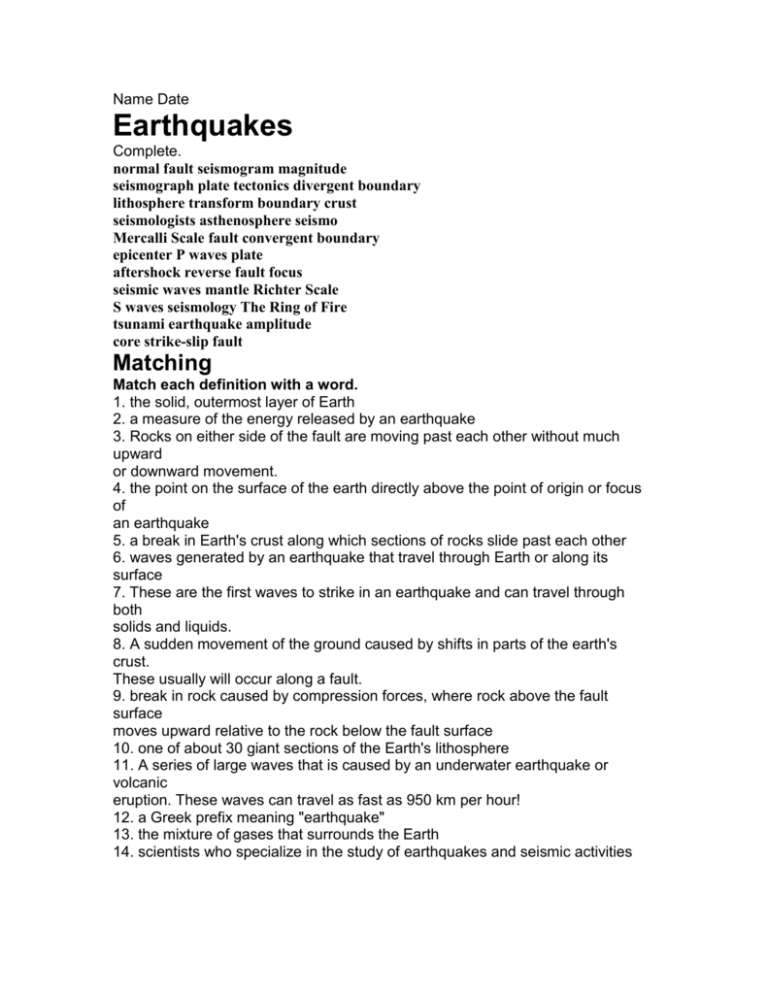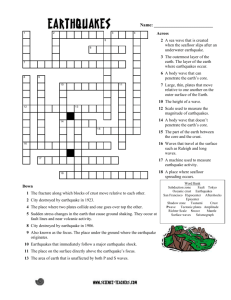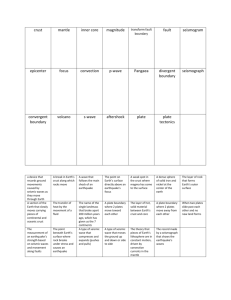Name Date
advertisement

Name Date Earthquakes Complete. normal fault seismogram magnitude seismograph plate tectonics divergent boundary lithosphere transform boundary crust seismologists asthenosphere seismo Mercalli Scale fault convergent boundary epicenter P waves plate aftershock reverse fault focus seismic waves mantle Richter Scale S waves seismology The Ring of Fire tsunami earthquake amplitude core strike-slip fault Matching Match each definition with a word. 1. the solid, outermost layer of Earth 2. a measure of the energy released by an earthquake 3. Rocks on either side of the fault are moving past each other without much upward or downward movement. 4. the point on the surface of the earth directly above the point of origin or focus of an earthquake 5. a break in Earth's crust along which sections of rocks slide past each other 6. waves generated by an earthquake that travel through Earth or along its surface 7. These are the first waves to strike in an earthquake and can travel through both solids and liquids. 8. A sudden movement of the ground caused by shifts in parts of the earth's crust. These usually will occur along a fault. 9. break in rock caused by compression forces, where rock above the fault surface moves upward relative to the rock below the fault surface 10. one of about 30 giant sections of the Earth's lithosphere 11. A series of large waves that is caused by an underwater earthquake or volcanic eruption. These waves can travel as fast as 950 km per hour! 12. a Greek prefix meaning "earthquake" 13. the mixture of gases that surrounds the Earth 14. scientists who specialize in the study of earthquakes and seismic activities 15. the point underground where the movement of an earthquake first takes place 16. a recording produced by a seismograph. 17. the science that studies earthquakes and their causes 18. a scale that measures the damage caused by an earthquake at different locations 19. an earthquake which follows a larger earthquake and originates at or near the focus of the larger earthquake 20. A device that records earthquake waves. This helps to calculate the time, strength, and duration of earthquakes. 21. the seismic active region of earth, including the crust and upper mantle; this layer of the earth is approximately 62 miles thick 22. This is where two plates are moving away from each other. New crust is formed here. 23. 80% of all major earthquakes in the world happen here 24. a theory that explains movements of continental and oceanic plates as well as changes in earth's crust and mantle as a result of internal forces 25. the layer of Earth, under the crust, in which plate movement is generated 26. This is where two plates are sliding past each other. Crust is neither produced nor destroyed. 27. the innermost layer of Earth 28. These are the second waves to strike in an earthquake and can travel through solids, but these waves cannot travel through liquids. 29. a numerical scale used to measure the magnitude or energy release of an earthquake 30. break in rock caused by tension forces, where rock above the fault surface moves down relative to the rock below the fault surface 31. This is where two plates are moving towards each other and where crust is destroyed when one plate is pushed beneath the other plate. 32. the size of a seismic wave generated by an earthquake Multiple Choice Select the definition that most nearly defines the given word. 33. seismologists A. the mixture of gases that surrounds the Earth B. scientists who specialize in the study of earthquakes and seismic activities 34. convergent boundary A. This is where two plates are moving towards each other and where crust is destroyed when one plate is pushed beneath the other plate. B. A series of large waves that is caused by an underwater earthquake or volcanic eruption. These waves can travel as fast as 950 km per hour! 35. amplitude A. the size of a seismic wave generated by an earthquake B. waves generated by an earthquake that travel through Earth or along its surface 36. The Ring of Fire A. the point on the surface of the earth directly above the point of origin or focus of an earthquake B. 80% of all major earthquakes in the world happen here 37. core A. 80% of all major earthquakes in the world happen here B. the innermost layer of Earth 38. lithosphere A. a numerical scale used to measure the magnitude or energy release of an earthquake B. the seismic active region of earth, including the crust and upper mantle; this layer of the earth is approximately 62 miles thick 39. plate tectonics A. This is where two plates are moving towards each other and where crust is destroyed when one plate is pushed beneath the other plate. B. a theory that explains movements of continental and oceanic plates as well as changes in earth's crust and mantle as a result of internal forces 40. seismo A. an earthquake which follows a larger earthquake and originates at or near the focus of the larger earthquake B. a Greek prefix meaning "earthquake" 41. Richter Scale A. a numerical scale used to measure the magnitude or energy release of an earthquake B. a theory that explains movements of continental and oceanic plates as well as changes in earth's crust and mantle as a result of internal forces 42. epicenter A. the layer of Earth, under the crust, in which plate movement is generated B. the point on the surface of the earth directly above the point of origin or focus of an earthquake 43. seismic waves A. waves generated by an earthquake that travel through Earth or along its surface B. the solid, outermost layer of Earth 44. tsunami A. the seismic active region of earth, including the crust and upper mantle; this layer of the earth is approximately 62 miles thick B. A series of large waves that is caused by an underwater earthquake or volcanic eruption. These waves can travel as fast as 950 km per hour! 45. seismograph A. the point underground where the movement of an earthquake first takes place B. A device that records earthquake waves. This helps to calculate the time, strength, and duration of earthquakes. 46. aftershock A. an earthquake which follows a larger earthquake and originates at or near the focus of the larger earthquake B. These are the first waves to strike in an earthquake and can travel through both solids and liquids. 47. P waves A. These are the first waves to strike in an earthquake and can travel through both solids and liquids. B. Rocks on either side of the fault are moving past each other without much upward or downward movement. 48. mantle A. the layer of Earth, under the crust, in which plate movement is generated B. This is where two plates are sliding past each other. Crust is neither produced nor destroyed. 49. seismogram A. a Greek prefix meaning "earthquake" B. a recording produced by a seismograph. 50. crust A. the solid, outermost layer of Earth B. the science that studies earthquakes and their causes 51. divergent boundary A. This is where two plates are moving away from each other. New crust is formed here. B. a measure of the energy released by an earthquake 52. asthenosphere A. the mixture of gases that surrounds the Earth B. This is where two plates are moving away from each other. New crust is formed here. 53. plate A. one of about 30 giant sections of the Earth's lithosphere B. a break in Earth's crust along which sections of rocks slide past each other 54. earthquake A. A sudden movement of the ground caused by shifts in parts of the earth's crust. These usually will occur along a fault. B. scientists who specialize in the study of earthquakes and seismic activities 55. strike-slip fault A. break in rock caused by tension forces, where rock above the fault surface moves down relative to the rock below the fault surface B. Rocks on either side of the fault are moving past each other without much upward or downward movement. 56. fault A. the innermost layer of Earth B. a break in Earth's crust along which sections of rocks slide past each other 57. Mercalli Scale A. These are the second waves to strike in an earthquake and can travel through solids, but these waves cannot travel through liquids. B. a scale that measures the damage caused by an earthquake at different locations 58. S waves A. These are the second waves to strike in an earthquake and can travel through solids, but these waves cannot travel through liquids. B. the size of a seismic wave generated by an earthquake 59. normal fault A. A device that records earthquake waves. This helps to calculate the time, strength, and duration of earthquakes. B. break in rock caused by tension forces, where rock above the fault surface moves down relative to the rock below the fault surface 60. magnitude A. a recording produced by a seismograph. B. a measure of the energy released by an earthquake 61. focus A. one of about 30 giant sections of the Earth's lithosphere B. the point underground where the movement of an earthquake first takes place 62. transform boundary A. a scale that measures the damage caused by an earthquake at different locations B. This is where two plates are sliding past each other. Crust is neither produced nor destroyed. Review 63. Which seismic waves can move through solid rock? A. P waves B. S waves C. Surface waves D. All of the above E. None of the above 64. The strength of an earthquake is ranked on the basis of the average amplitude recorded by nearby seismograph stations. A. False B. True 65. How much bigger is a magnitude 9.2 earthquake than a 6.7 earthquake? A. 78 times B. 25 times C. 316 times D. 5,351 times Based on the theory of plate tectonics, earthquakes usually occur at ____. A. Hot spots B. Divergent boundaries C. Convergent boundaries D. Convergent boundaries and transform fault boundaries E. Transform fault boundaries 67. Seismic waves change direction and speed as they travel through different densities of rocks. A. False B. True 68. Earthquakes can produce both transverse and longitudinal waves. A. True B. False 69. Body waves can travel through solid rock and fluids, but surface waves can only move through solid rock. A. True B. False 70. Earthquakes with a magnitude of 2.0 or less are called microearthquakes. A. False B. True 71. The National Earthquakes Hazards Reduction Program (NEHRP) is a nationwide program to mitigate hazards caused by earthquakes. Which government agency is NOT one of the NEHRP agencies? A. The International Code Council (ICC) B. The Federal Emergency Management Agency (FEMA) C. The National Science Foundation (NSF) D. The United States Geological Survey (USGS) 72. Which of the following statements is true? A. Deep earthquakes refer to earthquakes deeper than 700 km. B. The Richter Scale starts at one and has no upper limit. C. Normal faults are formed where the plate above the fault moves up and pushes into another plate. D. An increase of one magnitude unit represents a factor of releasing ten times more energy.








